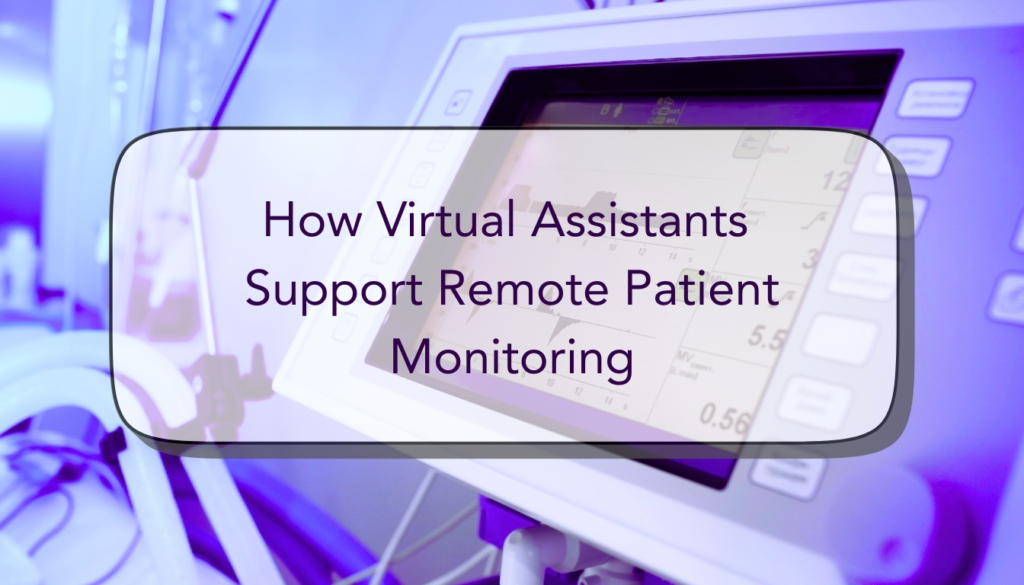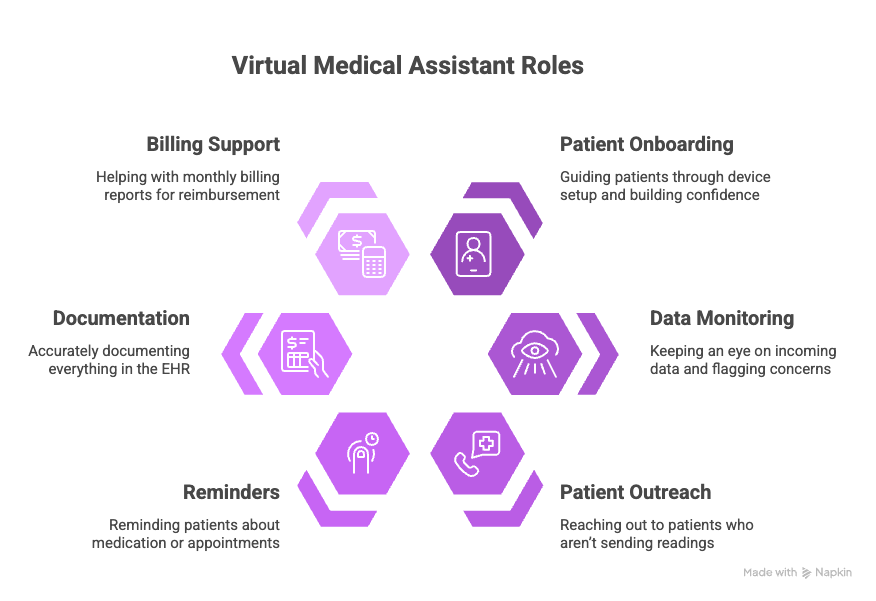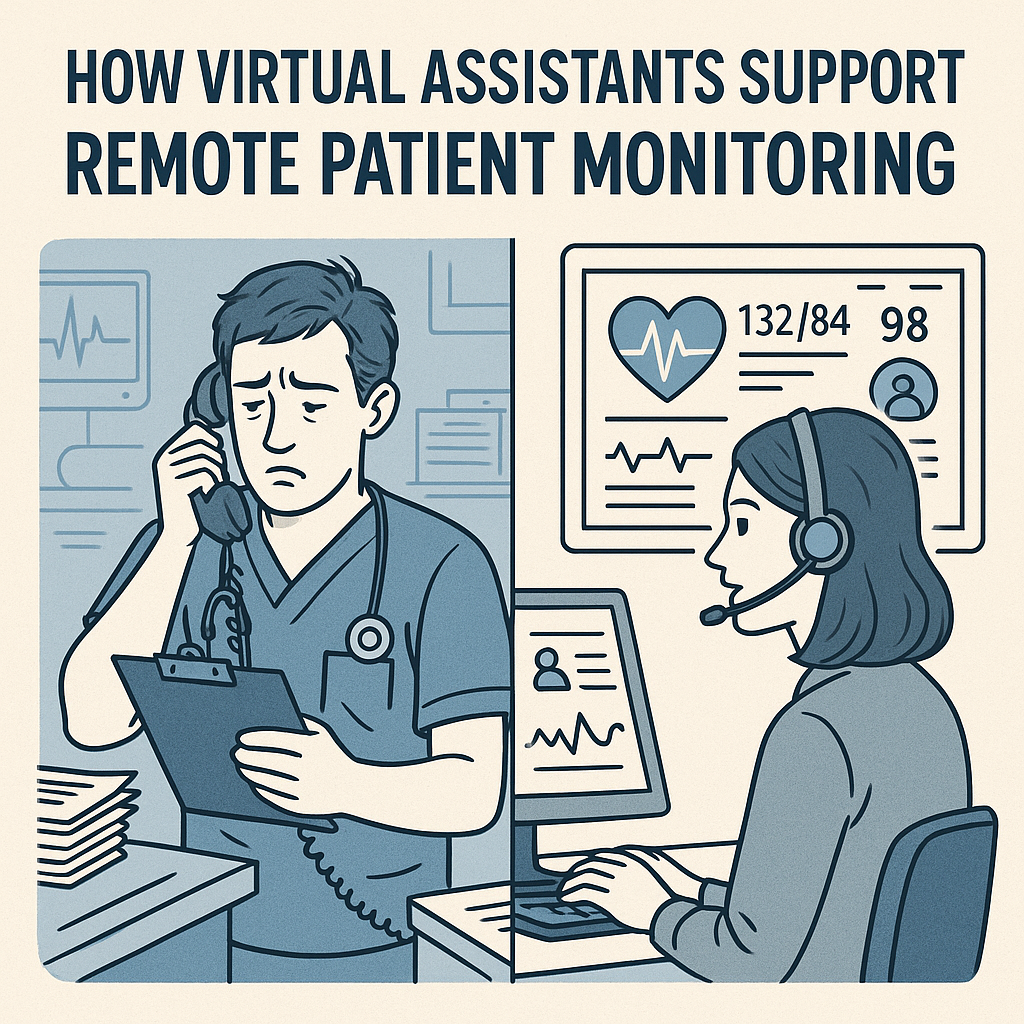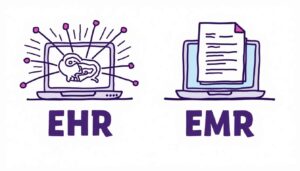How Virtual Assistants Support Remote Patient Monitoring
25 Nov 2025 By: Maria Rush
Updated
A lot of clinics are getting interested in Remote Patient Monitoring. And for good reason. It helps track patients with chronic conditions, catch issues early, and prevent emergencies. But there’s one thing most clinics struggle with: “We don’t have enough people to run it.”
And that’s fair. Adding a whole new layer of work (onboarding patients, checking daily readings, following up, and documenting everything) feels impossible.
That’s what made practices look into hiring a virtual medical assistant. Not AI nor software. A real person who helps behind the scenes so your team can focus on care. It’s made a big difference. RPM feels manageable now.
Here’s what we’ve learned about how to make it work.

What is Remote Patient Monitoring?
Remote Patient Monitoring (RPM) is a system that lets clinics track patients’ health from home using digital tools. This includes blood pressure cuffs, glucose monitors, pulse oximeters, and smart scales. These devices send real-time data to your clinic so you can keep tabs on patients with chronic conditions like hypertension, diabetes, or heart failure.
It’s a great way to catch problems early, reduce unnecessary hospital visits, and help patients stay healthier between appointments. But it only works if someone is watching the data and helping patients stay on track.
How Does Remote Patient Monitoring Work?
Once a patient is enrolled, they use remote patient monitoring devices to take daily readings at home. Those readings get sent to your clinic through a secure platform. From there, it’s up to your team to monitor the data, respond to alerts, follow up with patients, and keep records updated.
All of that takes time. And when you’re already juggling appointments, phones, and paperwork, it’s easy for things to be overwhelming.
How Virtual Medical Assistants Help With Remote Patient Monitoring

Virtual medical assistants play a hands-on role in keeping your RPM program running day to day. They help with onboarding and monitoring. Part of their task is to also build trust with your patients and support your staff in real ways that make the whole system work better. They step in where your team doesn’t have the time or capacity. This includes checking data trends, coordinating reminders, or logging time for billing. They’re part of what makes RPM actually sustainable.
A virtual medical assistant can:
- Guide patients through device setup so they feel confident using the technology
- Keep an eye on incoming data and flag anything concerning
- Reach out to patients who aren’t sending readings
- Remind patients about medication or appointments
- Document everything accurately in your EHR
- Help with monthly billing reports so you get reimbursed
Instead of having your in-house team try to do it all, the assistant handles the behind-the-scenes work that makes remote patient monitoring operations run.
Getting Patients Started Without Stress
One of the most common sticking points I’ve seen is just getting patients enrolled. Some are older and aren’t tech-savvy. Some get overwhelmed by the device instructions.
A virtual assistant can walk each patient through setup, step by step. They explain how to use the remote patient monitoring devices in plain language, answer questions, and make sure everything’s working before the first reading is sent. That first impression matters a lot. Patients who feel supported from the beginning are way more likely to stick with it.
Keeping Tabs on Data and Alerts
When you’re managing 20, 50, or even 200 RPM patients, the stream of data never stops. Some practices get flooded with charts and alerts, and it’s easy to miss something important.
Virtual assistants are great at watching the numbers. They track trends, spot red flags, and escalate the right issues to your team. That means you only get pulled in when it really matters. The rest of the time, you can trust that someone reliable is keeping an eye on everything.
Helping Patients Stay on Track
One of the biggest reasons remote patient monitoring fails is because patients stop using it. They forget to take readings, lose motivation, or don’t understand why it matters.
A virtual assistant helps with that too. They follow up with gentle reminders, answer basic questions, and check in when someone’s falling behind. It’s not automated text blasts either. It’s a real person who builds a relationship with your patients.
That kind of human touch goes a long way in keeping patients engaged.
Logging the Details for Billing
RPM isn’t just clinical work. There’s a mountain of documentation and billing involved. Time tracking. Reading logs. Reporting requirements.
A virtual assistant can take care of all of that. They document interactions, update charts, and help pull together everything needed for monthly billing. That means fewer claim rejections, faster reimbursement, and less admin stress on your staff.
Secure, HIPAA-Compliant Support
Letting someone outside your clinic handle patient data might feel risky. I get it. But services like HelpSquad train every assistant in HIPAA compliance. They use secure systems, sign Business Associate Agreements (BAAs), and follow strict privacy rules.
So yes, the support is remote. But it’s safe, professional, and fully accountable.
Around-the-Clock Help Without Burning Out Your Team
Health doesn’t follow office hours. Your RPM alerts don’t stop at 5 PM. But your staff can’t work 24/7.
Virtual assistants can. You can have someone watching data, handling alerts, and checking on patients around the clock. That keeps patients safer, makes your clinic look more responsive, and gives your in-house team room to breathe.
And as your RPM program grows, you can add more assistant coverage instead of scrambling to hire more full-time staff.
Trending Now
A new update making waves in healthcare tech is Anura’s “magic mirror,” a contactless health-monitoring system that lets patients check vital signs just by standing in front of it. No cuffs, wires, or tapping buttons. The mirror uses built-in AI and optical sensors to read things like heart rate, respiratory rate, blood pressure trends, and even stress markers in seconds. It connects through 4G, so patients can use it at home while clinics receive real-time data without needing extra devices or manual uploads.
For RPM programs that already feel overloaded, tools like this could make monitoring smoother, faster, and way more user-friendly especially for patients who struggle with traditional devices. It’s the kind of tech shift that makes remote care feel a little more effortless for everyone involved.
Conclusion

At the end of the day, this is what it’s really about: helping your staff focus on the care they’re trained to give. A virtual assistant handles the busy work. Your nurses and doctors handle the people.
When everyone’s working in their zone, patients get better care, staff feel less overwhelmed, and your RPM program actually works.
A Smarter, More Affordable Way to Support Remote Patient Monitoring
Hiring full-time staff for remote patient monitoring jobs isn’t always realistic. It’s expensive. It takes time. And sometimes you just don’t have the people.
HelpSquad gives you access to a trained, HIPAA-compliant virtual assistant who is flexible, fast, and cost-effective. You get expert support, and you can scale it up or down as your needs change.
If you’re serious about making your RPM program work without stretching your staff to the limit, this is the kind of support that makes it possible.
Want to see how HelpSquad’s virtual medical assistants can support your RPM program? Let’s talk.
FAQ
What is Remote Patient Monitoring and why are clinics using it?
Remote Patient Monitoring, or RPM, lets clinics track patients’ health from home using devices like blood pressure cuffs, glucose monitors, pulse oximeters, and smart scales. These tools send daily readings straight to the clinic so providers can catch issues early and prevent emergencies. Clinics love RPM because it improves patient outcomes, reduces hospital visits, and supports long-term chronic care. The only challenge is having enough staff to manage all the data and follow-ups.
How does a virtual medical assistant support Remote Patient Monitoring?
A virtual medical assistant handles the day-to-day work that makes RPM run smoothly. They help enroll patients, guide them through device setup, monitor incoming data, flag concerning readings, reach out when someone stops submitting results, log details in your EHR, and prepare documentation for billing. They take care of the busy work so your clinical team can focus on patient care instead of paperwork.
Is patient data safe when using a virtual assistant for RPM?
Yes. With HelpSquad, every virtual medical assistant is trained in HIPAA compliance and uses secure systems. They follow strict privacy protocols, sign a Business Associate Agreement (BAA), and only work inside protected platforms. You get the extra help without risking patient confidentiality.
Why do clinics outsource RPM support instead of hiring more staff?
Most clinics simply do not have the bandwidth to run an RPM program in-house. Onboarding, monitoring, documentation, billing, and follow-up messages take hours every day. Outsourcing gives you a trained assistant who can handle all of that at a fraction of the cost of hiring full-time staff. It also lets you scale your RPM program quickly without months of recruiting and training.
Where do we get the information used in this article?
Everything shared here is based on real healthcare sources and emerging technology updates, including industry reports and verified news from medical technology outlets like MPO Magazine. We also draw on hands-on RPM experience from clinics supported by HelpSquad’s virtual medical assistants, so the insights come from both research and real-world practice.
Supercharge Your Remote Patient Monitoring Workflow
Streamline administrative tasks, boost efficiency, and enhance patient care with dedicated virtual assistant support. See how HelpSquad can transform your operations.


